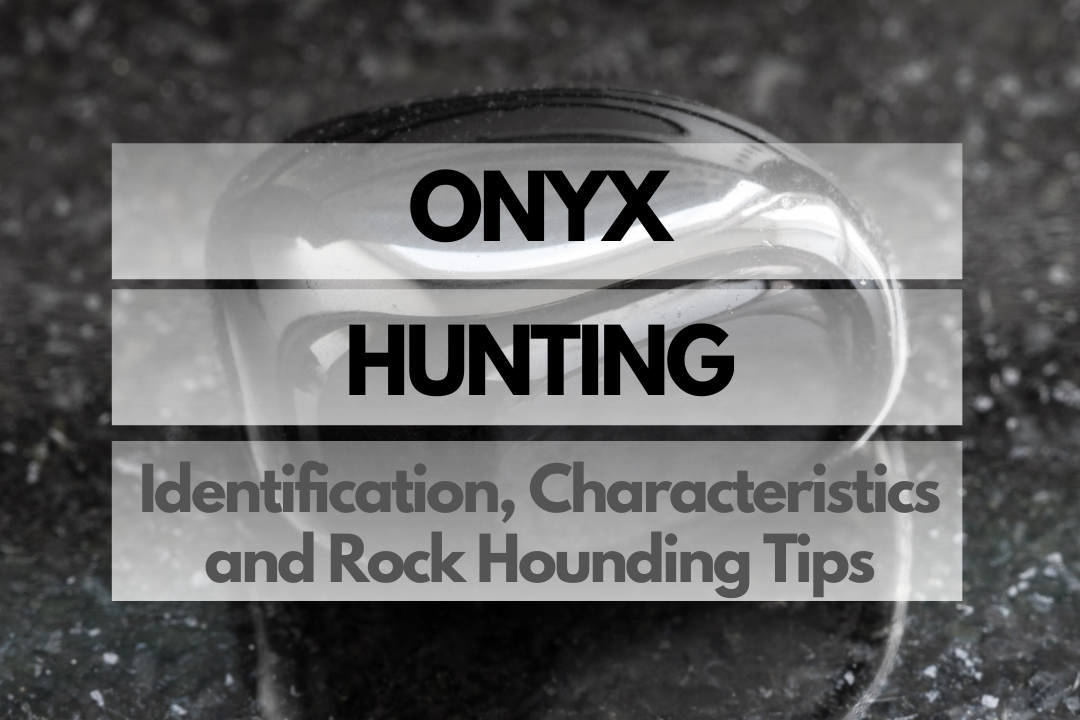Welcome to the fascinating world of onyx hunting! Onyx, a stunningly beautiful stone, has been used for centuries in decorative and practical applications. With its striking patterns and deep, rich colors, it’s no wonder that onyx is a sought-after treasure for rock enthusiasts and collectors. In this article, we’ll explore the history and origin of onyx, its identification and physical properties, the various types of onyx, and its many uses. So, let’s dive in and uncover the secrets of this alluring stone!
History & Origin of Onyx
Onyx has a long and storied history dating back to ancient civilizations. The name “onyx” comes from the Greek word “????,” meaning “claw” or “fingernail,” as ancient Greeks believed the stone resembled a human fingernail. Onyx was highly valued by the Romans, who used it to create intricate carvings and jewelry. Throughout history, onyx has been associated with various cultures and mythologies, often symbolizing protection, strength, and grounding energy.
Onyx Identification & Physical Properties
Onyx is a variety of chalcedony, a microcrystalline form of quartz. It is characterized by its distinctive parallel bands of color and its fine, compact texture. The table below provides a summary of the key physical properties of onyx:
| Property | Value |
|---|---|
| Chemical Formula | SiO2 |
| Crystal System | Trigonal |
| Cleavage | None |
| Fracture | Conchoidal |
| Specific Gravity | 2.55 – 2.70 |
Onyx Colors
Onyx can be found in a range of colors, including black, white, red, brown, and green. The most common and sought-after variety is black onyx, which often features contrasting white bands. The colors of onyx are typically formed by impurities within the chalcedony, such as iron, manganese, and other trace elements.
Onyx Hardness
Onyx has a hardness of 6.5 – 7 on the Mohs scale, making it a relatively hard and durable stone. It is resistant to scratches and can be polished to a high luster, making it an ideal choice for jewelry and decorative carvings.
Onyx Types
There are several different types of onyx, each with its own unique colors and patterns. Some of the most popular types include:
Black Onyx
Black onyx is the most well-known and highly valued type of onyx. It is characterized by its deep black color and contrasting white bands. This striking appearance makes it a popular choice for jewelry and decorative carvings.
Sardonyx
Sardonyx is a variety of onyx that features reddish-brown and white bands. The name “sardonyx” comes from the combination of “sard,” a reddish-brown variety of chalcedony, and “onyx.” Sardonyx has been used for centuries to create intricate cameos and intaglios.
Green Onyx
Green onyx is a less common type of onyx that features green and white bands. The green color is typically caused by the presence of trace amounts of chromium or nickel within the chalcedony. Green onyx has a unique, soothing appearance and is sometimes used in jewelry and decorative items.
Onyx Uses
Onyx has a wide range of uses, both practical and decorative. Some of the most common uses for onyx include:
- Jewelry: Onyx is often used in rings, necklaces, bracelets, and earrings due to its durability, luster, and striking appearance.
- Carvings: The hardness and fine texture of onyx make it ideal for creating intricate carvings and sculptures.
- Cameos and intaglios: Onyx, particularly sardonyx, has been used for centuries to create detailed cameos and intaglios, a type of engraved gem.
- Home decor: Onyx is sometimes used to create decorative items such as vases, bowls, and statues.
- Building materials: Some types of onyx are used as a building material, often in the form of tiles or slabs, for a luxurious and unique appearance.
How Much Is Onyx Worth?
The value of onyx can vary greatly depending on factors such as color, pattern, quality, and size. In general, black onyx with well-defined, contrasting bands is the most valuable. Onyx prices can range from a few dollars per carat for lower-quality stones to over $100 per carat for exceptional specimens. When considering the value of onyx, it’s essential to take into account its overall appearance, craftsmanship (in the case of jewelry or carvings), and any associated history or provenance.
Onyx Rock Hounding Tips
Now that you know all about the fascinating world of onyx, it’s time to embark on your own rock hounding adventure! In this section, we’ll share some tips and tricks for a successful onyx hunt, including essential tools and equipment, safety tips, where to find onyx, and how to care for your precious finds.
Essential Tools and Equipment
Having the right tools and equipment can make all the difference in your onyx hunting experience. Here are some essentials you’ll want to bring along:
- Rock hammer: A sturdy rock hammer is essential for breaking open rocks and revealing any hidden onyx.
- Chisel: A chisel can help you extract onyx from surrounding rock without damaging the specimen.
- Hand lens or magnifying glass: A hand lens or magnifying glass will help you identify onyx and inspect its unique features up close.
- Bucket or backpack: Bring along a sturdy container to hold your onyx finds and any other interesting rocks you come across.
- Gloves: Protective gloves will help you avoid cuts and scrapes while handling sharp rocks and tools.
- Field guide: A field guide specific to onyx or general rock hounding will help you identify specimens and learn more about their properties.
Safety Tips
Rock hounding can be a fun and rewarding hobby, but it’s important to keep safety in mind. Follow these safety tips to ensure a successful and injury-free onyx hunting experience:
- Always wear protective gear, such as gloves, safety glasses, and sturdy footwear.
- Be aware of your surroundings and watch for potential hazards, such as loose rocks, steep slopes, or wildlife.
- Stay hydrated and bring along plenty of water, especially when hunting in hot or arid environments.
- Never go rock hounding alone. Bring a buddy or join a group to ensure someone is there to help in case of an emergency.
- Respect private property and always ask for permission before entering or collecting on private land.
Onyx Hunting: Where to Find Onyx
Onyx can be found in various locations around the world, with some countries and regions being particularly well-known for their onyx deposits. The table below provides information on specific sites and areas where you can find onyx:
| Site/Area | Location |
|---|---|
| Honey Onyx Mine | Utah, USA |
| San Luis Potosi | Mexico |
| Madagascar Onyx Quarry | Madagascar |
| Pakistan Onyx Mines | Pakistan |
| Brazilian Onyx Quarries | Brazil |
Caring For Your Onyx
Once you’ve found some beautiful onyx specimens, it’s important to care for them properly to preserve their natural beauty. Here are some tips for caring for your onyx:
- Clean your onyx using a soft brush and mild soap. Avoid using harsh chemicals or abrasive materials that could scratch or damage the stone.
- Store your onyx specimens in a cool, dry place, away from direct sunlight, which can cause the colors to fade over time.
- If you plan to display your onyx, consider investing in a protective case or stand to prevent damage from dust and handling.
- Handle your onyx carefully to avoid accidentally dropping or chipping the stone.
Additional Resources
For further information and guidance on onyx hunting and rock hounding in general, check out the following resources:
- U.S. Geological Survey: Information on geology, mineral resources, and more from the United States government.
- Mindat.org: An extensive online database of minerals, rocks, and their localities.
- Rockhound Lounge: A forum for rock hounding enthusiasts to discuss their finds, share tips, and connect with others in the community.
- Books: There are many books available on rock hounding, onyx, and other minerals. Some popular titles include “Rockhounding: A Guide to Minerals, Gems, and Fossils” by Paul T. Adams and “The Rockhound’s Handbook” by James R. Mitchell.
Additional Onyx FAQs
What are the benefits of Onyx?
Onyx is a beautiful and unique stone that can be used for various purposes. Some benefits of onyx include its use in jewelry, home decor, and as a collector’s item for rock hounding enthusiasts. Onyx is also believed to have various metaphysical properties, though these claims are not supported by scientific evidence.
Do Onyx have any healing properties?
While many people believe that onyx has healing properties, there is no scientific evidence to support these claims. However, the beauty and uniqueness of onyx can bring a sense of joy and appreciation for the natural world, which may have positive effects on one’s well-being.
Do Onyx have any spiritual meaning?
Onyx has been associated with various spiritual meanings and beliefs throughout history, such as protection, grounding, and self-discipline. It is important to note that these spiritual associations are based on personal beliefs and cultural traditions, and not on scientific evidence.
Do I need a permit to go Onyx hunting?
In some cases, a permit may be required to collect onyx or other rocks and minerals on public lands. Regulations vary by location, so it’s essential to research the specific rules and requirements for the area where you plan to hunt onyx. For more information on permits in the United States, visit the Bureau of Land Management’s website.
Closing Thoughts
Onyx hunting can be an exciting and rewarding hobby for those who appreciate the beauty and wonder of the natural world. By following the tips and advice shared in this article, you’ll be well-prepared for a successful onyx hunting experience. So grab your rock hammer, gather your essential equipment, and head out on your own rock hounding adventure. Who knows what incredible onyx treasures await?

